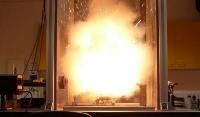Oscillating Ions imitate optical Laser
MPQ/Caltech scientists demonstrate mechanical analogue to an optical laser with single ions
For decades there has been interest in phonon lasers that emit quanta of vibrational energy - so called phonons - instead of light. In solids, because of the short wavelength, the implementation of such a device would make it possible to achieve unprecedented resolution in imaging techniques like tomography. The experiment carried out at MPQ is still quite a bit away from these kinds of applications. However, scientists of the Laser Spectroscopy Division of Prof. Theodor W. Hänsch in cooperation with Prof. Kerry Vahala of the California Institute of Technology, at present guest scientist at MPQ, were able to demonstrate for the first time the effect of coherent phonon generation with a single magnesium ion cooled to a temperature of around 1 milli-Kelvin in an electromagnetic trap. Stimulus to this process is blue-detuned laser radiation. As the scientists report in Nature Physics this device represents a mechanical analogue to an optical laser that allows to investigate the fundamental dynamics of a phonon laser. The device in its present form could possibly be used as a sensor for extremely weak forces. The extension of the system to an ion chain or a two-dimensional ion array could perhaps make the breakthrough to possible applications.

A series of ion luminescence pictures shows the amplification of the time-averaged vertical motion while the beam intensity is increased from the left (no amplification) to the right most image.
MPQ
The experiment starts with the preparation of a single magnesium ion in an electromagnetic so-called 'Paul-trap' that gets cooled down to temperatures of around one milli-Kelvin by laser cooling. This widely used technique exploits the fact that an ion irradiated with red-detuned (with respect to a suitable spectral line) laser light gets excited only when travelling towards the laser beam thus losing more and more kinetic energy. This setup represents a mechanical oscillator with adjustable quality factor, analogue to an optical laser resonator whose quality factor is given by the reflectivity of its mirrors.
Now a second laser comes into action, this time blue-detuned. Its purpose is to feed energy into the system, just like the energy source of an optical laser system. While in a series of experiments the intensity of the blue-detuned radiation is ramped up the centre-of-mass motion of the ion gets amplified. At a certain intensity, the threshold, a transition from thermal irregular motion to harmonic oscillations is observed, just like in an optical laser. But the analogy carries even further: The harmonic oscillation is initiated by a spontaneously emitted phonon and sustained by stimulated generation of phonons. Like in its optical counterpart, the oscillation of the ion is stabilized by amplification saturation. As is shown in the figure below, this behavior has in fact been observed and compared with theory by taking a series of time averaged pictures of the single oscillating ion. "An important step in the realization of this kind of phonon laser was the insight that blue-detuned laser light does not merely heat an ion as it is widely believed, but instead, by appropriate choice of frequency and intensity, can stimulate coherent amplification of its motion", Dr. Maximilian Herrmann of the Laser Spectroscopy Division explains.
Current research is directed towards controlling the phonon laser using tools and techniques that can be adapted from the laser world. One example is a technique called injection locking whereby a weak, external control field is used to phase-synchronize the phonon laser with an external reference. This method was used to generate a time resolved image of the coherent motion of the ion as it oscillates.
When implemented in a solid, a phonon laser could enable applications such as high-resolution tomography. This task has yet been hampered by the large number of atoms in bulk solids. Therefore people are interested in one- or two-dimensional structures. "Our single-ion zero-dimensional system anticipates the endpoint of this development", Herrmann says. "It is ideally suited to investigate the transition to a one-dimensional system by adding further ions in a controlled way." Besides these fundamental aspects the scientists also consider to use the oscillating ion as a probe for extremely weak external forces, but "that's all still up in the air", Herrmann concedes. [Maximilian Herrmann/Olivia Meyer-Streng]
Original publication: K. Vahala et al.; "A phonon laser"; Nature Physics, Advance Online Publication, 16 August 09






















































